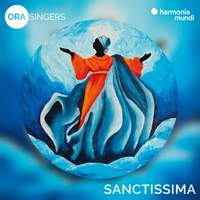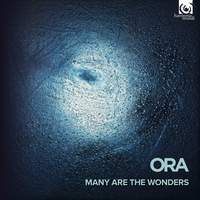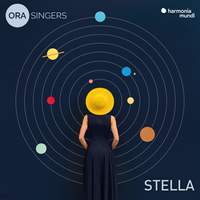Interview,
Suzi Digby on Sanctissima
Katherine was by no means the only one in the Presto office to have their attention drawn by this glorious and (to borrow her phrase) truly 'ear-opening' album; a little while ago I spoke to Suzi Digby as well, to dig into the inspirations behind the album, some of her broader motivations in musicmaking, and what the future holds for her acclaimed choir.
This album is a little different from previous ORA recordings, since in addition to mirroring the old with the new it’s also modelled quite closely on the liturgical structure of a real service. What inspired you to incorporate that element into this album?
We’ve long wanted to create something like a fantasy service, for the Feast of the Assumption of the Virgin Mary. We’re releasing it around the date of the feast in the liturgical calendar, and what we’ve done which makes it unique (and I have to say this is very much a team effort, with input from my artistic advisor David Clegg and our resident theologian and Latinist William Gaunt, who sings bass on the recording) is to construct a Vespers and Benediction service on that theme. That’s why it’s over two discs, not just one. And we weave everything through with the plainchant, which is very much the root of all the pieces of music that we use, so that there’s a real trajectory going through it all.
Having chosen Vespers as your model, I suppose some people might be wondering why you didn’t simply commission settings of the plainchant Vesper Psalms themselves (Dixit Dominus, Laudate pueri and so forth) from your composers…
We might have done, but for this project it was very specifically about using the plainchant, which is the origin of both the Renaissance works and the reflections. So we wanted that element to remain intact in order to provide the sense of consistency through the service.
James MacMillan's Ave Maris Stella, performed by the ORA Singers
There must be an unfathomable number of motets, anthems, hymns and indeed recordings devoted to the Virgin Mary. What is it about her that has kept composers, artists, poets and others coming back to her over the centuries as a source of inspiration?
It triggers the imagination, unlike any other figure. She’s been venerated since the earliest days of Christianity and is seen by many as the greatest of all the saints; Immaculate Conception, Assumption into Heaven, being the Mother of God, the Virgin Birth – these are all above everything else. Retaining her virginity intact during childbirth, being free of original sin, being spared bodily decay before the Assumption – and yes, she’s been the inspiration for so very many artists. She’s mentioned in the Qur’an several times and is the most highly-regarded of all women in Islam, absolutely on another level. Beautiful, pure, everything like that.
I’ve been thinking about this – Mary is really so much more than a woman. And yet the fact that she is a woman is also important – the maternal nature and the pureness.
And merely being a woman, against a pretty patriarchal backdrop, sets her apart in and of itself...

Oh, yes – and in addition to that the simple fact that everyone has a mother, and the symbolism of that. The nurturing aspect. And then also being free from original sin, as a woman, is something that is endlessly fascinating. It transcends the impulse to demonise women (which goes all the way back to the story of Adam and Eve). It’s a very, very interesting subject.
And of course there’s feminine beauty and youth in the mix too. Though having said that, there’s a really wonderful depiction of her by Donatello as an older woman – it’s extraordinary and almost disconcerting because it’s so different to what you’re expecting.
The phrase “in our increasingly secular age” is becoming a bit of a cliché these days, but it’s certainly not wholly inaccurate. What do you think this collection of psalms and Marian motets offers to people who don’t relate to Catholic doctrines and saints?
This is an issue that faces all of us in choral music! I would say rather than “in an increasingly secular age”, it’s more like an increasingly philistine age, where I believe there is a hunger for beauty and the aesthetic, and spirituality. And art provides this, in a way that I think transcends religious dogma and structure. Michelangelo’s Pietà, for instance – you look at that and it doesn’t matter whether you have any relationship with religion at all. It’s viscerally overwhelming, the beauty of it, and the subject and the history of that subject and the religious symbolism are only a part of that.
In art you have the subject – which in choral music is the text – and you have the creativity, which is how that is brought by an individual composer into an aesthetic form, and then you have the execution of it, which is the performance. So if you equate that with the Pietà, or visual depictions of anything religious (which of course was almost exclusive before society became so secular), to experience music of this nature and calibre really does impact in a way that is quite complex.

We hear about how the “uninitiated” very often take refuge in plainchant – when there was that fashion for plainchant a few decades ago, the people taking an interest were not predominantly monks or Catholics! – and it has a mood-impact, as it were. We know a bit about how the brain responds to sounds, though it would be helpful to know more. But we do know that music affects mood, and people will know it instantly. The extreme example would be someone who is an atheist or an agnostic and also hungers for the beauty that I mentioned, and also for respite and for creativity. Not all of the music on these discs is what one might categorise straightforwardly as calming, or “relaxing” or even “chillout”, but it does take you to a place which transcends the everyday and its problems.
This is what I mean – the philistinism of our age creates an imperative and I think people are hungry for it, for this aesthetic, even if they’re not aware of it. Even something with disturbing subject matter can be extremely… intriguing, I suppose. And intellectually stimulating – it can have all sorts of points of intellectual and aesthetic interest.
Just as millions of people go to see the Pietà, but the majority today are probably not going for religious reasons, I think the same is true of the music. When I was young and I was singing this kind of music, long before I had any awareness of the texts, it never occurred to me to think about what the words meant – and yet it was still a soul-shifting experience for a young singer. And I don’t think it would actually have been enhanced if I had had a better understanding of the text.
We find this with our concert audiences, too – we try to make concerts immersive, so that you have a visual element too. Obviously focusing everyone on the text is very important, as that’s the starting point of everything, but I think you can disassociate yourself from any religiously participatory aspect and still get just as much out of it as a religious person would.
Choral music is less and less used for “functional” purposes these days anyway – moving a little bit closer to concert music.
Kim Porter's Pulchra es, performed by the ORA Singers
Each ORA album has had, if not exactly a “theme”, then at least a clear thread running through it and binding it together. Do you know what the next one will be - or is it more of an organic emergent process than a pre-planned “concept album”?
We try to look ahead and be as planned as possible, but of course we have to be agile and respond to circumstances. For instance, 2025 will be the 500th anniversary of the birth of Palestrina, and we’ll be responding to that. But in 2026 it will be our own first big milestone, our tenth anniversary. And we’ve pledged to have commissioned a hundred new works by a hundred composers by then. So that’s the overall structure; we’re currently on sixty-two out of that hundred! That’s the body of work which connects the two Golden Ages of choral music, as I see them – that of the Renaissance, and today’s Golden Age – through the Renaissance Gems and their Reflections series.
My desire is that with these hundred new works from our first ten years we can provide a snapshot of the genius of our age. Just as we look back to the Eton Choirbook and compilations like that. We’re looking to continue our regular output of recording releases; I’d love to continue our series of Gems and their Reflections with a focus on Palestrina, just as we did with Tallis, Byrd and Victoria. We’re also exploring potential ideas around a secular disc, and of course, a Christmas release may be in the works.
Embedded in all this we also have a set of Cultural Bridges commissions, which is a new genre that we’re developing. Post-Covid – which paused us on our fiftieth commission, the Vidi aquam by James MacMillan – everything in the world seemed to be shifting, countries turning in on themselves and so on, and I felt a very strong imperative to put into this body of work a set of commissions that had that function of being cultural bridges. The idea of these is to find a composer who has a foot in both cultures – “our” culture, in terms of the Western choral canon, and the culture of their origin.
But they have to be composers who are comfortable with both; we’re not a group like Roomful of Teeth who experiment with different soundworlds and different types of singing. We sing in a certain way and the commission has to work with that. So what I’ve done is to commission a number of composers from all over the world to compose dialogues, in a sense, between ORA Singers and indigenous stringed instruments from their respective cultures. It’s been a very interesting series, and we’ll be recording those as a series of independent singles – we may release them all together but it’s difficult because they’re all so different from one another. The texts of these pieces are a combination of English and the original language.
James MacMillan's Vidi aquam, performed by the ORA Singers
We’ve just commissioned the multi-Grammy-winning composer Richard Danielpour, who’s based in Los Angeles and is of Iranian Jewish descent, and he’s writing a piece partly in Farsi, incorporating poetry by Rumi, and partly in English, which will incorporate an Iranian harp. Then we have Shruthi Rajasekar, who’s written us an amazing piece with her mother Nirmala, who is an amazing veena [South Indian stringed instrument resembling a lute] player, in dialogue with us. And of course it’s very complex, because the rāgas [modes used in Indian Classical music] have all sorts of tonalities which are difficult to square with diatonicism. Because she’s so musically bilingual, she’s been able to create this.

And we have South American, Caribbean, African, Chinese and other bridges planned. It will be a group of seven, because my original point of inspiration was Haydn’s Creation – in my view that’s the first truly bicultural work, because it was written in English and German, and both languages are equally the original, rather than one being a translation. Haydn had one foot in England, having absorbed English choral culture over his lifetime, and one foot in Austria. So I thought: why not a series of works on the creation of light? And so the first seven are linked to the seven days of Creation (the numerology of it is very interesting to me) and that will be the unifying theme.
ORA Singers, Suzi Digby
Available Formats: 2 CDs, MP3, FLAC, Hi-Res FLAC, Hi-Res+ FLAC
ORA Singers, Suzi Digby
Available Formats: MP3, FLAC, Hi-Res FLAC
ORA Singers, Suzi Digby
Available Formats: CD, MP3, FLAC, Hi-Res FLAC
ORA Singers, Suzi Digby
Available Formats: CD, MP3, FLAC, Hi-Res FLAC, Hi-Res+ FLAC







